Architecture Home Styles
Building Durable Adobe Houses: A Comprehensive How-To Guide
Tap into the ancient art of adobe building to unlock the secrets of timeless durability and sustainable living…
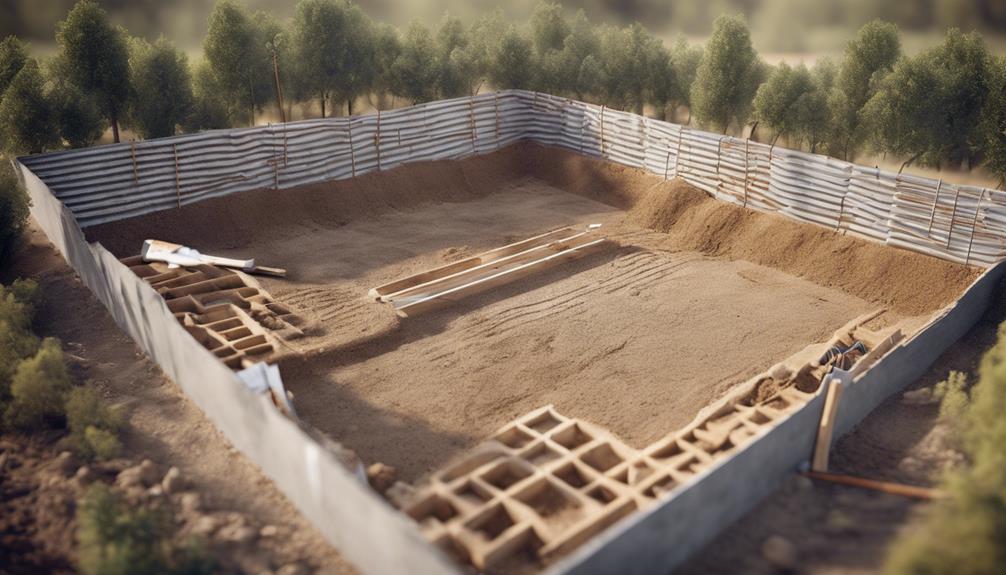
When it comes to building durable adobe houses, we view the process as laying a strong foundation for not just a physical structure but also for sustainable living. Imagine the resilience and eco-friendliness of a home that harmonizes with nature, embodying a timeless connection to the earth.
In this guide, we explore the intricate steps and essential considerations for creating adobe houses that withstand the test of time, blending traditional wisdom with modern techniques. Join us as we uncover the secrets to constructing homes that embrace durability, efficiency, and the beauty of natural materials.
Key Takeaways
- Optimize adobe materials for cohesion, stability, and strength.
- Implement precise brick-making and curing techniques for durability.
- Construct solid foundations with proper soil preparation and reinforcement.
- Focus on strategic wall design, insulation, and finishing for longevity.
Selecting the Right Adobe Building Materials
When selecting the right adobe building materials, it's crucial to consider the composition of adobe bricks, including clay, sand, water, and sometimes straw, to ensure durability and strength. Adobe, a traditional building material, relies on the proper combination of these elements to create robust structures. Clay provides cohesion and binding properties, while sand adds stability and reduces shrinkage during drying. Water acts as the medium for mixing and activating the clay, ensuring proper adhesion within the mixture. In some cases, straw is incorporated to enhance tensile strength and reduce cracking.
Optimizing the ratio of clay to sand is vital in achieving the desired structural integrity. Too much clay can lead to excessive shrinkage and cracking, while an excess of sand may compromise the brick's cohesion. Understanding the ideal balance between these components is fundamental to producing high-quality adobe bricks for construction.
Additionally, the incorporation of stabilizers like asphalt emulsion can further enhance the waterproofing and durability of adobe structures, increasing their resistance to weathering and moisture infiltration.
Preparing the Site for Construction
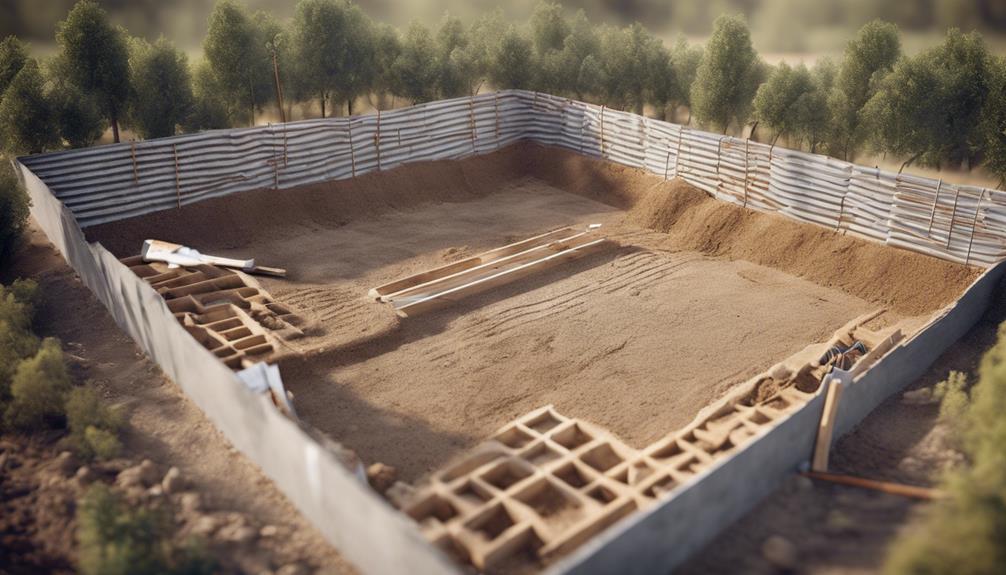
Proper site preparation for constructing durable adobe houses involves meticulous grading, leveling, and marking of corner stakes to ensure precise foundation placement. Before laying the foundation, digging trenches and flooding the area can help establish a solid base for the construction. It's crucial to assess the soil composition and drainage to guarantee the stability of the site. Simple yet robust footing designs are essential to support the weight of the adobe structure effectively.
Furthermore, attention to detail in ground preparation is paramount. This includes compacting the soil adequately and pouring concrete to create a durable foundation that can withstand the test of time. By taking these preparatory steps seriously, the construction process can proceed smoothly, ensuring that the adobe house is built on a stable and secure site. Careful site preparation is the foundation upon which the entire construction project rests, making it a critical aspect of building durable adobe houses.
Making and Curing Adobe Bricks
To ensure the structural integrity of our adobe houses, the process of making and curing adobe bricks is a critical step that demands precision and careful attention to detail. Adobe bricks are typically formed by mixing clay, sand, straw, and water to create a durable building material. After molding the bricks into shape, the curing process begins. This involves allowing the adobe bricks to dry slowly and evenly to prevent cracking. It's essential to turn the bricks regularly during curing to ensure uniform drying and prevent deformities.
Properly cured adobe bricks should exhibit a hard exterior and be free of excess moisture before they're utilized in construction. The curing period is crucial, as adobe bricks gain strength over time. This process usually takes several weeks, with the duration varying based on weather conditions. Monitoring the curing process diligently is vital to producing high-quality adobe bricks that will contribute to the longevity and stability of the adobe construction.
Constructing the Adobe House Foundation
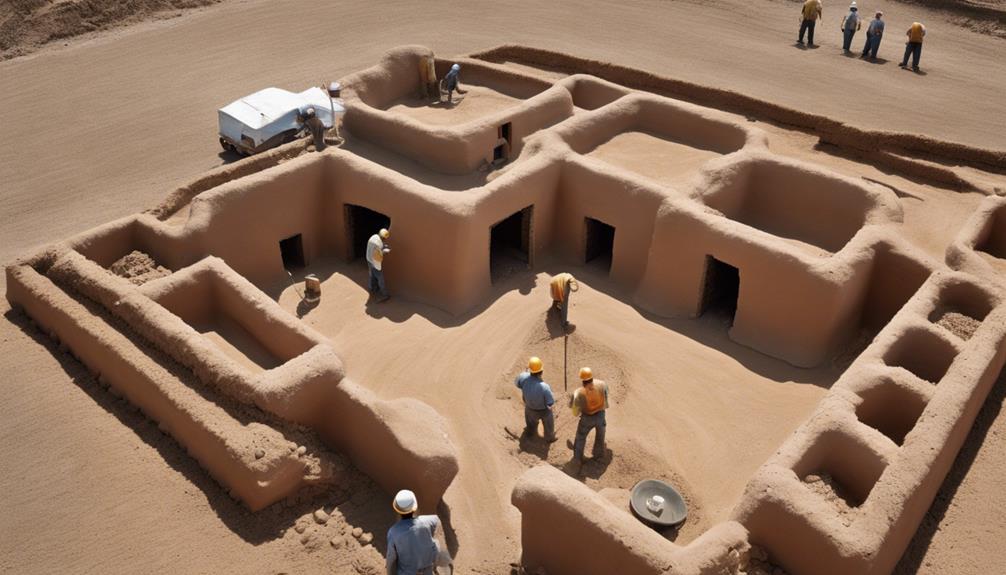
For the successful construction of an adobe house foundation, meticulous site grading and leveling are imperative steps in ensuring structural stability and longevity. Properly preparing the ground is essential to support the weight of the adobe structure and prevent future issues. Here are key points to consider:
- Trench Digging and Flooding: Digging trenches around the foundation area and flooding them with water can help compact the soil and create a solid base for the adobe house.
- Simple Footing Designs: Utilizing uncomplicated footing designs can effectively distribute the load of the adobe bricks and enhance the foundation's stability.
- Ground Preparation: Thorough planning and execution of ground preparation before pouring the slab are critical to establishing a robust foundation for the adobe house.
- Concrete Mixing: Precise concrete mixing techniques ensure the adobe house foundation's durability and strength, enhancing its ability to support the structure.
- Curing Processes: Proper curing of the concrete is vital for optimizing the foundation's longevity, ensuring it can withstand the weight of the adobe house over time.
Building Walls With Adobe Bricks
When building walls with adobe bricks, several critical steps must be followed.
We must pay close attention to the brick-making process, ensuring the right mixture of clay, sand, water, and organic materials for optimal strength.
Wall layout planning is crucial, determining the placement of doors, windows, and structural supports within the adobe structure.
Proper curing techniques are essential to allow the adobe bricks to dry uniformly and prevent cracking, ensuring a strong and durable wall construction.
Brick-Making Process
Using a precise mixture of clay, sand, water, and occasionally straw for binding, adobe bricks are crafted for construction purposes. When making adobe bricks, the process involves several steps:
- Mixing: Combine clay, sand, water, and straw in the right proportions to form a workable mixture.
- Molding: Pack the mixture into brick molds, ensuring they're well-compacted to avoid cracking.
- Drying: Allow the bricks to air-dry in the sun or kiln-fire them for enhanced strength and durability.
- Curing: After drying, cure the bricks slowly to prevent cracking and ensure uniform strength.
- Testing: Conduct quality checks to ensure the bricks meet strength and durability standards before using them in construction.
Wall Layout Planning
In planning the layout of walls using adobe bricks, we prioritize structural stability and adherence to architectural design requirements. To accommodate plumbing and electrical needs, service columns within walls must be carefully planned.
In earthquake-prone regions, incorporating seismic reinforcement strategies is crucial for enhanced safety. Proper spacing and alignment of adobe bricks are essential to maintain consistent wall strength and integrity.
For a blend of traditional aesthetics and structural stability, consider incorporating curved walls and rounded corners in the layout. These features not only contribute to the visual appeal of the adobe walls but also add to their overall strength and durability.
Proper Curing Techniques
Properly curing adobe bricks is essential to ensure the strength and durability of walls constructed with adobe bricks. When building an adobe house, the curing process plays a crucial role in the overall structural integrity. Here are some key techniques to follow:
- Slow and Even Drying: Allow the adobe bricks to dry gradually to prevent cracking.
- Moisture Regulation: Cover the adobe bricks with plastic to control moisture evaporation.
- Duration: Cure the adobe bricks for several weeks to ensure thorough drying.
- Readiness: Ensure the bricks are fully dried and ready for building stable walls.
- Importance: Inadequate curing can lead to weakened walls and long-term structural issues.
Roofing and Insulating Your Adobe House

To ensure optimal thermal performance and structural integrity of your adobe house, incorporating proper insulation and selecting the appropriate roofing design are critical steps in the construction process. Insulating an adobe house involves integrating straw or other fibrous materials into the adobe mixture, enhancing its thermal properties.
When it comes to roofing options, flat roofs with parapets offer protection to the walls, while sloped roofs with overhangs shield the adobe from moisture infiltration. These choices not only safeguard the structure but also aid in regulating indoor temperatures, reducing reliance on heating and cooling systems.
For enhanced protection, it's essential to install a vapor barrier between the adobe walls and the roof. This barrier prevents moisture from seeping into the adobe, safeguarding it from potential damage. Moreover, ensuring adequate roof insulation and ventilation is crucial for preventing condensation buildup, which can compromise the structural integrity of your adobe house.
Finishing Touches and Maintenance
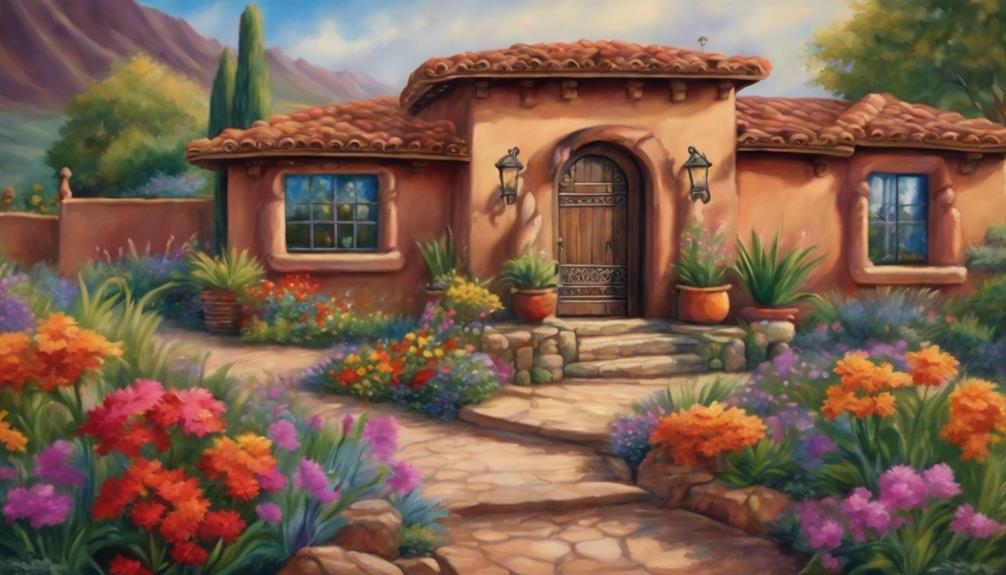
Maintaining the outward appearance and structural integrity of adobe homes requires diligent attention to finishing touches and regular maintenance routines. To ensure your adobe house remains in top condition, consider the following key points:
- Finishing Touches: Utilize paint, stains, linseed oil, and tiles to enhance the aesthetic appeal of your adobe home.
- Regular Maintenance: Implement a routine maintenance schedule to preserve the durability and longevity of the adobe structure.
- Ceiling Insulation: Properly insulate ceilings to regulate internal temperature and enhance energy efficiency within the adobe house.
- Fittings and Flooring: Select appropriate fittings and flooring materials to complete the interior design of your adobe residence.
- Longevity: With proper care and maintenance, adobe homes can stand the test of time, retaining their charm and structural integrity for centuries.
Enhancing Durability Through Proper Design

To enhance the durability of adobe houses, we focus on a strong foundation design, weather-resistant materials, and a strategic structural layout.
These key points work together to ensure the longevity and resilience of the structure against various environmental factors.
Strong Foundation Design
Enhancing the durability of adobe houses through proper design necessitates meticulous attention to the foundation's structural integrity. When designing a strong foundation for an adobe house, several key factors need consideration:
- Adequate Site Preparation: Proper site grading, leveling, and corner stake placement are crucial.
- Trench Digging and Flooding: Techniques used to create a stable foundation for the adobe structure.
- Footing Design Options: Simple yet effective designs to support the weight of the adobe house.
- Concrete Mixing: The correct mixing ratios are essential for a durable foundation.
- Curing Process: Proper curing techniques ensure the foundation's strength and longevity.
A well-designed foundation is the cornerstone of a durable adobe house, ensuring its stability and longevity.
Weather-Resistant Materials
Ensuring the weather resistance and durability of adobe houses relies heavily on the meticulous selection and utilization of appropriate materials. When constructing a Modern Home with real adobe, prioritizing weather-resistant materials is crucial.
Stabilized soil is a key component for making durable adobe bricks that can withstand various weather conditions. By waterproofing adobe bricks with asphalt emulsion stabilizer, their resistance to moisture and weathering is significantly enhanced. The proper incorporation of stabilizer ratios during the adobe brick-making process is essential to ensure the longevity and durability of the structure.
Additionally, adobe bricks made with stabilized soil offer exceptional insulation properties against heat, cold, and sound, making them ideal for creating a weather-resistant and durable home. Selecting the right mold types for adobe brick making further contributes to the overall weather resistance of the structure.
Strategic Structural Layout
In strategic structural layout for adobe houses, incorporating thick walls ranging from 10-24 inches is essential for ensuring stability and effective temperature regulation. Utilizing locally sourced materials such as clay, sand, and straw for adobe bricks enhances durability and sustainability.
Deep-set windows can be strategically incorporated to optimize energy efficiency and introduce ample natural light into the interior. The use of organic shapes with rounded corners in the layout not only contributes to a visually appealing design but also mirrors the earth-based materials, ultimately fortifying the structural integrity of the house.
Additionally, strategic design considerations like space optimization, passive solar design, and natural ventilation play pivotal roles in ensuring long-lasting durability and resilience in adobe houses.
Frequently Asked Questions
How to Build an Adobe House Step by Step?
To build an adobe house step by step, we first prep the site by grading and leveling for the foundation. After digging trenches and flooding the area, we design and pour footings.
Next, we mix and cure concrete for a solid base. Then, we focus on making durable adobe bricks from stabilized soil, waterproofing them for longevity.
Detailed diagrams and materials lists guide us through the construction process effortlessly.
What Is the Best Foundation for an Adobe House?
For the best foundation of an adobe house, we typically recommend a rubble trench foundation filled with rocks and gravel. This type of foundation provides essential support for the weight of the adobe walls.
Another suitable option is a reinforced concrete strip footing, offering stability and structural support.
In areas with expansive clay soils, pier and beam foundations are also effective, promoting ventilation and minimizing moisture issues.
Consider soil conditions, local climate, seismic activity, and wall weight for proper foundation design.
How Durable Are Adobe Houses?
Durability of adobe houses is remarkable. The thick walls offer excellent insulation and protection.
Proper roof overhangs and drainage systems are vital in preventing water damage. Stabilized adobe bricks can withstand weathering and seismic activity.
Regular maintenance, like resealing, is crucial for long-term durability. Maintaining these factors ensures adobe houses can last for centuries.
What Are the Disadvantages of Adobe Homes?
When considering the disadvantages of adobe homes, it's important to note their susceptibility to moisture damage, cracking from temperature changes, and the labor-intensive nature of construction.
Regular maintenance like resealing and plastering is necessary to prevent erosion and water infiltration. Additionally, in seismic regions, adobe houses may require additional reinforcement to mitigate structural damage risks.
These factors highlight the challenges associated with building and maintaining adobe homes.
Conclusion
After following the steps outlined in 'Building Durable Adobe Houses: A Comprehensive How-To Guide', we can confidently say that the theory of constructing long-lasting adobe homes is indeed true.
By carefully selecting materials, preparing the site properly, and following the construction process meticulously, we've created a sturdy and sustainable home that will stand the test of time.
With the right knowledge and techniques, anyone can build their own durable adobe house.
- About the Author
- Latest Posts
Introducing Ron, the home decor aficionado at ByRetreat, whose passion for creating beautiful and inviting spaces is at the heart of his work. With his deep knowledge of home decor and his innate sense of style, Ron brings a wealth of expertise and a keen eye for detail to the ByRetreat team.
Ron’s love for home decor goes beyond aesthetics; he understands that our surroundings play a significant role in our overall well-being and productivity. With this in mind, Ron is dedicated to transforming remote workspaces into havens of comfort, functionality, and beauty.
Architecture Home Styles
How to Explore Native Houses in Indonesia
Catch a glimpse of Indonesia's cultural treasures through native houses, where each intricate detail holds a secret waiting to be discovered.

So, you think you've seen it all in Indonesia? Well, think again. Exploring native houses in this diverse archipelago offers a glimpse into a world where tradition meets craftsmanship in a harmonious blend.
From the intricate carvings to the unique architectural designs, each house tells a story waiting to be uncovered, inviting us to step into a realm where time seems to stand still.
But what lies beyond the façade of these cultural gems is a journey that promises to unravel the tapestry of Indonesia's rich heritage, revealing a side often overlooked by many travelers.
Key Takeaways
- Visit Batak, Toraja, and Joglo Houses for diverse architectural experiences.
- Discover intricate carvings and symbolic details in traditional Indonesian homes.
- Immerse in cultural heritage through communal spaces and ancient craftsmanship.
- Learn about Indonesia's rich history and values by exploring native houses.
Traditional Houses in Indonesia
In Indonesia, traditional houses embody rich cultural heritage through their unique architectural designs and symbolism. Among these remarkable dwellings, the boat-shaped houses stand out for their distinctive characteristics. The Batak House, found in certain regions, showcases intricate carvings and utilizes natural materials, reflecting a deep connection to the environment. These boat-shaped structures not only serve as homes but also as symbols of cultural identity and traditions passed down through generations.
The boat-shaped design of these traditional houses in Indonesia not only provides shelter but also represents a deeper meaning within the community. The intricate carvings on the Batak House, for example, tell stories of ancestry and spiritual beliefs, adding layers of significance to the architectural aesthetics. Through these boat-shaped dwellings, the indigenous peoples of Indonesia honor their heritage and preserve their cultural roots in a rapidly changing world.
Cultural Significance of Indigenous Dwellings

Exploring the intricate cultural significances embedded within indigenous dwellings in Indonesia unveils a tapestry of architectural symbolism and traditional values that resonate deeply within the communities they inhabit. These houses serve as more than mere shelters; they embody the cultural beliefs and practices of the diverse Indonesian tribes. The multi-generational living arrangements seen in houses like the Rumah Gadang in West Sumatra and the Rong Houses in Dayak communities highlight the importance of family and community ties in Indonesian society.
Moreover, the communal living spaces found in the Tongkonan House in Tana Toraja and the Uma Lulik in Timor foster a sense of togetherness and shared responsibilities among the inhabitants. Each architectural element, from the intricate carvings to the circular shapes and elevated stilts, holds deep symbolic meaning rooted in centuries-old traditions. These indigenous dwellings aren't just physical structures but living embodiments of Indonesia's rich cultural heritage, where every beam and wall tells a story of cultural continuity and communal harmony.
Top Native Houses to Visit
With intricate architectural designs and rich cultural symbolism, a journey to explore the top native houses in Indonesia promises a captivating immersion into the country's diverse heritage. Here are some of the top native houses you shouldn't miss:
| Native House | Features |
|---|---|
| Batak Houses | Boat-shaped roofs, intricate carvings, spaces for daily life activities like a living room and dining room. |
| Toraja Houses | Distinct saddleback roof design, used in ceremonies, areas for daily life such as a living room and dining room. |
| Joglo Houses | Elaborate wooden structures, symbolizing social hierarchy, with designated spaces for a living room and dining room. |
These native houses offer insights into the daily lives of the people inhabiting them. From the communal spaces like the living room where gatherings take place to the dining room where meals are shared, each house reflects the cultural practices and traditions of its respective community. Exploring these spaces provides a unique opportunity to understand the interconnectedness between architecture, daily life, and cultural identity in Indonesia.
Exploring Architectural Features

Amidst the vibrant tapestry of Indonesia's architectural landscape, one encounters a rich mosaic of cultural intricacies within the native houses that stand as living testaments to the country's diverse heritage. As we delve into exploring the architectural features of these remarkable dwellings, we're greeted by a fusion of craftsmanship and symbolism that captivates the senses:
- Boat-shaped roofs that gracefully mimic the curves of traditional Indonesian vessels, offering a nod to the nation's maritime history.
- Intricate carvings adorning the facades and interiors, telling stories of myths, legends, and ancestral wisdom.
- Wooden craftsmanship that showcases the mastery of artisans, each piece meticulously crafted to perfection.
- Natural materials seamlessly integrated into the structures, connecting the homes to the earth and reflecting a harmonious relationship with nature.
- Symbolic details embedded in every corner, from the layout to the decorations, embodying cultural beliefs and societal values passed down through generations.
Exploring these architectural marvels unveils a world where history, artistry, and tradition converge in a celebration of Indonesia's rich cultural heritage.
Immersing in Indonesian Hospitality
Immerse yourself in the captivating tapestry of traditional Indonesian hospitality by residing in native houses like the Batak House in North Sumatra or the Rumah Gadang in West Sumatra. These native houses not only offer a place to stay but also provide a gateway to the cultural heritage of Indonesia. The intricate carvings, boat-shaped roofs, and eco-friendly construction of these houses showcase the deep-rooted traditions and craftsmanship of the local communities.
Here is a table highlighting some of the unique aspects of traditional Indonesian hospitality found in native houses:
| Aspect | Description |
|---|---|
| Architectural Features | Intricate carvings, boat-shaped roofs |
| Social Significance | Symbolism of social hierarchy in houses like the Joglo House in Central Java |
| Eco-Friendly Construction | Use of sustainable materials like bamboo and thatch in houses like the Sasak House in Lombok |
| Spiritual Connections | Preservation of spiritual connections and communal living traditions in houses like the Uma Lulik in Timor or the Honai House in Papua |
| Local Way of Life | Experience the daily lives and customs of the local communities while staying in these native houses |
Staying in these native houses will not only provide you with a unique accommodation experience but also a deep dive into the rich tapestry of Indonesian traditions and hospitality.
Frequently Asked Questions
What Are Traditional Indonesian Houses Called?
Traditional Indonesian houses are called 'Rumah Adat.' These structures are more than just dwellings; they're living representations of Indonesia's rich cultural tapestry. Crafted from natural materials like wood and thatch, they stand as testaments to the country's diverse traditions.
Each region boasts its own unique design, influenced by local customs and beliefs. Exploring these native houses allows us to delve into the heart of Indonesia's vibrant heritage and architectural ingenuity.
What Is Indonesian Housing Like?
Indonesian housing embodies a rich tapestry of cultures and traditions, showcasing unique architecture and sustainable practices. From boat-shaped roofs to intricate carvings, these homes reflect a deep connection to nature and community.
Families often live together in multi-story structures, fostering bonds and kinship. Sustainability and cultural symbolism intertwine in Indonesian homes, creating a harmonious blend of functionality and heritage preservation.
Each dwelling tells a story of tradition, innovation, and unity.
What Is Typical Indonesian Housing?
We'll dive into the essence of typical Indonesian housing, showcasing the diverse array of styles like Batak, Toraja, Joglo, and more. These houses boast unique architectural features, reflecting the rich heritage of Indonesia's indigenous communities.
From intricate carvings to bamboo and thatch construction, each house tells a story of cultural significance and tradition. Multi-generational living arrangements further deepen the bond between people, highlighting the social and spiritual connections within the community.
What Is a House Called in Indonesia?
In Indonesia, a house is often referred to as a 'rumah' in Bahasa Indonesia. These structures aren't merely places of dwelling; they embody the essence of Indonesian culture and heritage.
Each region has its unique names for traditional houses, such as 'rumah adat' or 'rumah suku,' showcasing the diverse architectural styles and craftsmanship.
These homes serve as living monuments, reflecting the country's history, beliefs, and social structure.
Conclusion
In conclusion, exploring native houses in Indonesia is like taking a journey through a living museum of cultural heritage. Each traditional dwelling tells a story of the past and present, showcasing the craftsmanship and traditions of its people.
By immersing ourselves in these architectural wonders, we can truly appreciate the beauty and diversity of Indonesia's indigenous cultures. So, let's hit the road and dive into the rich tapestry of Indonesian history – the world is our oyster!
- About the Author
- Latest Posts
Introducing Ron, the home decor aficionado at ByRetreat, whose passion for creating beautiful and inviting spaces is at the heart of his work. With his deep knowledge of home decor and his innate sense of style, Ron brings a wealth of expertise and a keen eye for detail to the ByRetreat team.
Ron’s love for home decor goes beyond aesthetics; he understands that our surroundings play a significant role in our overall well-being and productivity. With this in mind, Ron is dedicated to transforming remote workspaces into havens of comfort, functionality, and beauty.
Architecture Home Styles
How Do You Mix Modern and Traditional Art Styles?
Balancing the fusion of modern and traditional art styles in a space can be a captivating challenge – want to know the secret?

When it comes to blending modern and traditional art styles, finding the perfect equilibrium can seem like an insurmountable task. However, by carefully curating a space that seamlessly fuses the two, the results can be awe-inspiring.
But how exactly can this be achieved? Stay tuned as we unravel the intricacies of merging these seemingly contrasting artistic realms to create a harmonious and captivating environment that speaks to the essence of both styles.
Key Takeaways
- Blend colors, materials, and shapes for a cohesive look.
- Establish harmony through shared textures and patterns.
- Use common color palettes and subtle details for cohesion.
- Integrate traditional and modern art for a stylish, effortless design.
Dominant Style Selection
Upon evaluating the home shell and architecture, we determine the dominant style by applying the 80/20 rule, allocating 80% for the primary style and 20% for the secondary style. To achieve a harmonious blend of modern and traditional design, we strategically place traditional pieces as the foundation, anchoring the space with their timeless elegance. Modern art with retro undertones can then be incorporated to infuse a touch of innovation and vitality. By integrating contemporary finds alongside vintage furniture, we create an eclectic yet cohesive overall look that seamlessly marries the two design styles.
Selecting the dominant style is crucial, as it sets the tone for the entire space. By opting for a mix of modern and traditional elements, we can strike a balance that's both refreshing and sophisticated. The key lies in seamlessly blending the two styles to create a visually stimulating environment that captivates the eye and sparks curiosity. When done thoughtfully, the fusion of modern and traditional design can result in a space that isn't only aesthetically pleasing but also rich in character and depth.
Harmony Vs. Contrast

After establishing the dominant style selection in a space blending modern and traditional art styles, the next crucial consideration is determining whether to prioritize harmony or contrast in the overall design approach. When mixing modern and traditional elements, the choice between harmony and contrast plays a significant role in the visual impact of the room.
| Harmony | Contrast |
|---|---|
| Evenly distribute elements from both styles | Use colors and materials to blend or contrast styles |
| Create a cohesive look | Achieve a bold and dynamic effect |
| Balance furniture choices for a calming harmony | Opt for striking contrasts to reflect personal style |
To achieve harmony, blend colors and materials seamlessly, integrating modern and traditional pieces throughout the room. Contrast, on the other hand, can be achieved by strategically placing items that diverge in style, color, or era. Whether aiming for a contemporary feel or a touch of vintage charm, the decision between harmony and contrast will define the overall aesthetic of the space.
Starting With Essential Pieces
We start the design process by focusing on selecting essential furniture pieces that will serve as the foundation for blending modern and traditional art styles in the room. It's crucial to establish a strong base with key elements such as traditional seating arrangements or larger units before introducing modern art pieces or contemporary furniture.
Sofas and tables play a vital role in setting the tone for the space, providing a canvas for layering different styles. When deciding on chairs, strategic placement can add personality and elevate the overall design. Narrowing down furniture choices based on the dominating style helps in determining whether to aim for harmony or contrast when mixing modern and traditional elements.
Tying Art Pieces Together

To achieve a cohesive blend of modern and traditional art styles in a space, the key lies in tying art pieces together through shared colors, shapes, textures, or patterns. When merging different art styles, it's essential to create visual harmony by incorporating common elements that bridge the gap between traditional and modern aesthetics.
Here are five strategies to unify art pieces effectively:
- Utilize a similar color palette: Using shared colors across traditional and modern artworks can create a cohesive appearance and tie the pieces together seamlessly.
- Focus on common shapes: Look for recurring shapes or forms in the art pieces to establish a visual connection and blend the styles cohesively.
- Consider shared textures: Incorporating similar textures in both traditional and modern art can enhance the overall visual cohesion of the space.
- Highlight recurring patterns: Identifying and emphasizing common patterns in the artworks can help unify them and create a harmonious look.
- Pay attention to subtle details: Small details in art pieces can play a significant role in blending traditional and modern styles, so focusing on these nuances is key to achieving a cohesive design.
Adding Final Touches
Incorporating strategic elements like velvet throw pillows and thoughtful lighting choices plays a crucial role in enhancing the fusion of modern and traditional art styles within a space. These final touches serve as the bridge that connects the two worlds, creating rooms that appear effortless and stylish. By mixing traditional and modern aesthetics with a neutral color palette, you can achieve a harmonious balance that's visually appealing.
When adding final touches, consider integrating a vintage piece of art alongside contemporary curves to add depth and character to the room. This juxtaposition of styles creates an eclectic atmosphere that's both intriguing and inviting. Combining modern and traditional styles in this manner allows for a seamless transition between the two, resulting in a space that feels cohesive and well-thought-out.
To master the art of mixing traditional and modern art styles, focus on layering textures, incorporating unexpected elements, and paying attention to the finer details. By following these design tips, you can transform your space into a great place to start experimenting with the fusion of vintage and contemporary art, ultimately achieving a look that's both timeless and fresh.
Frequently Asked Questions
Can You Mix Modern and Traditional Styles?
Yes, we can seamlessly blend modern and traditional styles to create a captivating fusion. By intertwining contemporary elements with classic artistry, we achieve a design that's both timeless and cutting-edge.
This harmonious marriage of old and new offers a fresh perspective and cultivates a rich visual tapestry. Embracing the juxtaposition of modern and traditional styles leads to an innovative approach that sparks creativity and intrigue in interior design.
How Do You Blend Traditional and Modern?
When blending traditional and modern art styles, we aim for a seamless integration that harmonizes the contrasting aesthetics. Finding commonalities in colors, shapes, and textures between the two styles is key.
What Is the Combination of Traditional and Modern Design Called?
The combination of traditional and modern design is known as 'Transitional' style. This aesthetic blends classic elements with contemporary features, creating a balanced and harmonious look.
It seamlessly integrates traditional and modern art pieces, offering a timeless and cohesive space. Transitional design emphasizes comfort, warmth, and simplicity with clean lines and a minimalistic approach.
It aims to merge elements from different eras to achieve a cohesive and innovative design.
How Do You Combine Different Art Styles?
When combining different art styles, we focus on harmony and contrast. By blending complementary colors and themes and experimenting with various mediums, we create a cohesive yet dynamic visual experience.
Symmetry and asymmetry play a crucial role in adding balance and interest to our art arrangements. Dominant styles serve as focal points, while contrasting ones add depth and dimension.
Ultimately, our goal is to personalize spaces and evoke a sense of creativity and innovation.
Conclusion
In conclusion, blending modern and traditional art styles is a delicate dance of balance and creativity. By carefully selecting a dominant style, harmonizing or contrasting elements, and layering essential pieces with unique art, textiles, lighting, and plants, a space can truly come to life.
Embracing imperfections and experimenting with unexpected themes adds depth and personality to the mix. The result? A visually captivating and harmonious fusion of the old and the new.
- About the Author
- Latest Posts
Introducing Ron, the home decor aficionado at ByRetreat, whose passion for creating beautiful and inviting spaces is at the heart of his work. With his deep knowledge of home decor and his innate sense of style, Ron brings a wealth of expertise and a keen eye for detail to the ByRetreat team.
Ron’s love for home decor goes beyond aesthetics; he understands that our surroundings play a significant role in our overall well-being and productivity. With this in mind, Ron is dedicated to transforming remote workspaces into havens of comfort, functionality, and beauty.
Architecture Home Styles
How to Have a Tiny Home in Arizona: Your Essential Guide
Fascinated by the idea of a tiny home in Arizona? Discover how tax considerations can impact your journey in this essential guide.
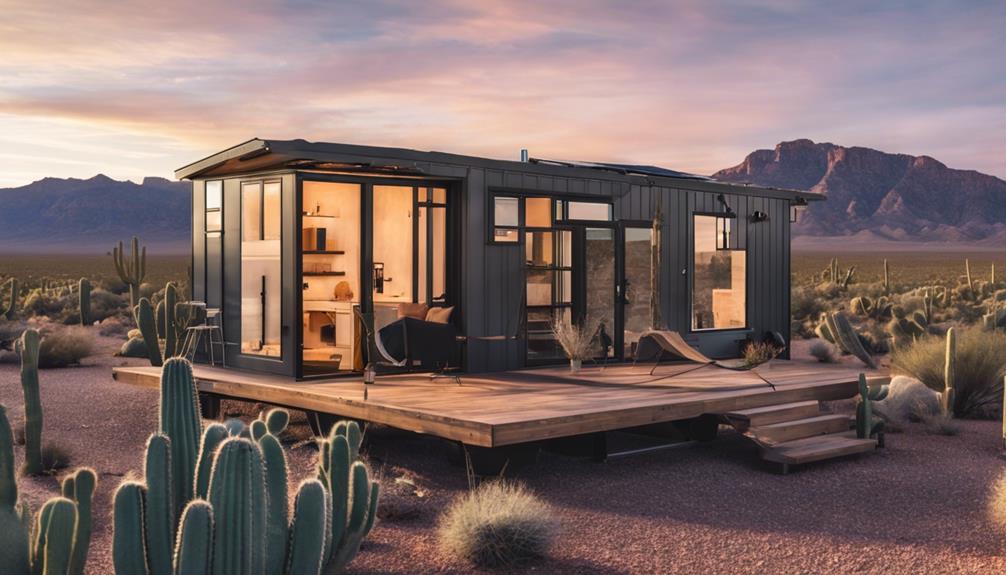
Embarking on the journey of having a tiny home in Arizona is like navigating through a desert oasis, each step revealing new insights and challenges. From understanding the intricate web of zoning laws to discovering the perfect location that aligns with your tiny living dreams, this essential guide equips you with the knowledge needed to turn your tiny home vision into reality.
But what about the unique tax considerations that come with owning a tiny home in Arizona? Stay tuned to uncover key insights that will make a difference in your tiny home journey.
Key Takeaways
- Understand Arizona zoning laws for placement in suitable zones.
- Seek permits for tiny homes based on location and structure type.
- Explore tax benefits for tiny homeowners through property tax exemptions.
- Build a supportive community through local groups and events for guidance.
Zoning Laws and Regulations in Arizona
When navigating the realm of tiny home living in Arizona, understanding the intricacies of zoning laws and regulations becomes paramount. In Arizona, zoning laws permit tiny houses on foundations in multifamily, detached single-family, and accessory dwelling unit zones.
However, for Tiny Homes on Wheels, they're typically classified as recreational vehicles and must adhere to specific parking regulations within designated zones. Maricopa County has established particular regulations for tiny houses, including constraints on the floor area allowed for permanent structures. On the other hand, Pima County imposes restrictions on Tiny Homes on Wheels through specific codes that govern their placement.
The zoning options for tiny houses in Arizona encompass various zones such as isolated single-family zones, accessory dwelling unit zones, and multifamily zones. Familiarizing oneself with these zoning laws and regulations is crucial for anyone considering embarking on the adventure of tiny home living in Arizona.
Ideal Locations for Tiny Homes
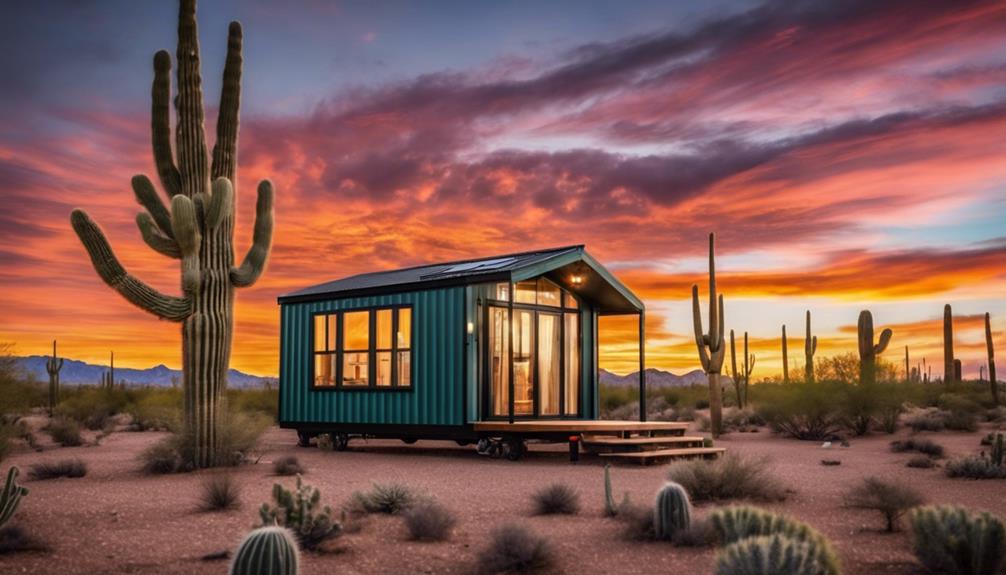
For those seeking ideal locations to establish their tiny homes in Arizona, cities like Phoenix, Tucson, Sedona, and Lakeside present attractive options. When considering where to set up your tiny home in Arizona, keep in mind that Pima County and Coconino County permit the establishment of tiny houses in specific zones. In these areas, tiny homes can be placed in isolated single-family zones, ADU zones, and multifamily zones. For those with tiny houses on wheels, it's important to note that they must be parked in designated R.V. zones in compliance with regulations.
- Phoenix, Tucson, Sedona, and Lakeside are ideal cities for setting up tiny homes in Arizona.
- Pima County and Coconino County allow tiny houses in specific zones.
- Tiny homes can be placed in single-family zones, ADU zones, and multifamily zones.
- Tiny houses on wheels must adhere to regulations in designated R.V. zones.
Tax Considerations for Tiny Home Owners
Exploring the tax implications of owning a tiny home in Arizona reveals potential benefits and considerations that can significantly impact financial planning for homeowners. Tiny home owners in Arizona may qualify for property tax exemptions based on factors like square footage and adherence to green building standards. Additionally, the size of tiny homes could lead to reduced property tax assessments in certain counties. It is crucial for Arizona tiny home owners to familiarize themselves with local tax laws to take advantage of any available tax benefits. Seeking guidance from a tax professional or local tax assessor can provide valuable insights into how owning a tiny home in Arizona may influence property taxes.
Tax Considerations for Tiny Home Owners:
| Key Points | Details | Importance |
|---|---|---|
| Property Tax Exemptions | Available based on square footage and green standards | Maximize Savings |
| Reduced Assessments | Smaller homes could mean lower tax bills | Financial Advantage |
| County Variances | Regulations differ, impacting tax benefits | Local Compliance |
| Professional Advice | Consult with tax professionals for guidance | Optimal Planning |
Finding Community Support in Arizona
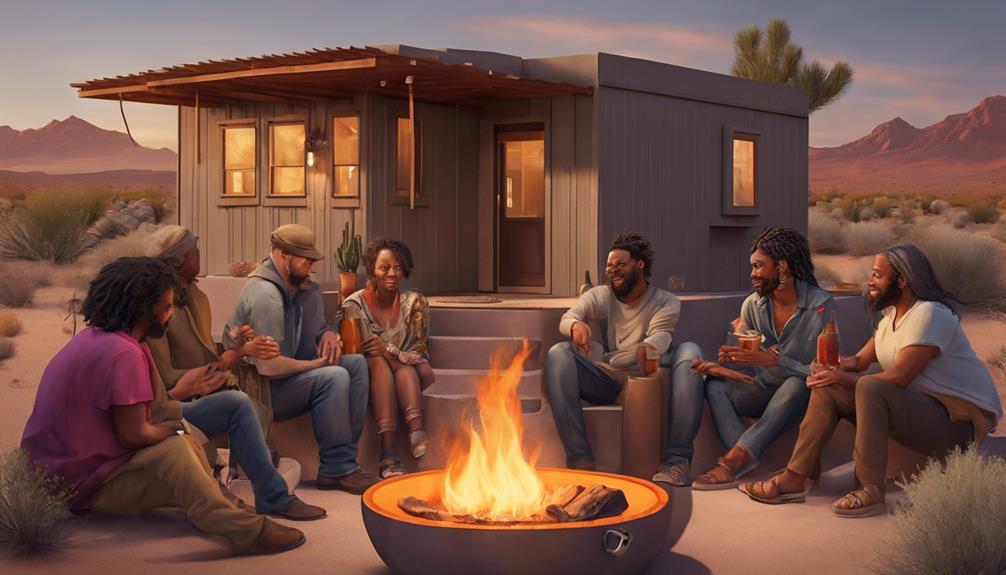
By actively engaging with local resources and networking opportunities, tiny home enthusiasts in Arizona can establish a strong sense of community support to enhance their living experience.
Here are some ways to find community support in Arizona:
- Join local Facebook groups like 'Arizona Tiny House Community' for a supportive network.
- Attend tiny house meetups and events in Arizona to connect with like-minded individuals.
- Explore tiny house workshops and seminars in the state to gain knowledge and resources.
- Consider volunteering with non-profit organizations focused on sustainable living and tiny house advocacy in Arizona.
These opportunities not only provide a sense of belonging within the tiny house community but also offer valuable insights, resources, and support for those embracing the tiny home lifestyle in Arizona.
Engaging with these avenues can enrich your experience, foster connections, and empower you to navigate the challenges and joys of sustainable living in the state.
Building and Parking Tips for Tiny Homes
Engaging with the regulations and guidelines for building and parking tiny homes in Arizona is crucial for ensuring compliance and a smooth transition into sustainable living. Tiny homes on foundations in Arizona must adhere to the 2018 IRC Appendix Q requirements, which outline specific space dimensions and safety features to guarantee structural integrity.
Building a tiny home on skids offers a semi-permanent placement option while still allowing for mobility if relocation becomes necessary. For those opting for tiny homes on wheels, meeting mobile home requirements is essential, and a minimum of 160 square feet is required for parking.
The flexibility in setting up tiny homes in various zone types in Arizona provides diverse housing options based on individual preferences. Tiny houses on wheels are particularly popular for their mobility and flexibility, making them an attractive choice for those desiring a minimalist lifestyle without sacrificing comfort.
Frequently Asked Questions
Can I Put a Tiny House on My Property in Arizona?
Yes, we can put a tiny house on our property in Arizona if it complies with local zoning regulations. Different options like multifamily, detached single-family, or accessory dwelling units are available. Land near Maricopa City, Pinal County, offers accessible placement.
How Much Does a Tiny House Cost in Az?
Tiny houses in Arizona can range from $20,000 to $200,000 depending on size and customization. DIY kits start at $8,000, but labor costs add up. Land, utilities, and permits are extra. Building a tiny house can be a cost-effective housing choice.
What Is the Minimum Square Footage for a House in Arizona?
In Arizona, the minimum square footage for a house varies based on its foundation type. For tiny houses on foundations, it's 200 square feet, while those on trailers require at least 160 square feet. Adhering to building codes is essential.
Does Arizona Have a Tiny Home Community?
We do have tiny home communities in Arizona. These communities provide shared amenities, community engagement, and a supportive environment. Living in a tiny house community offers a unique sense of belonging, shared resources, and a close-knit experience.
Conclusion
In conclusion, navigating the world of tiny homes in Arizona may seem like a daunting task, but with the right resources and community support, it can be a breeze.
From zoning laws to building tips, we've covered it all in our essential guide.
So go ahead, take the leap into tiny home living and watch your dreams of a cozy, sustainable lifestyle come to life in the Grand Canyon State!
- About the Author
- Latest Posts
Introducing Ron, the home decor aficionado at ByRetreat, whose passion for creating beautiful and inviting spaces is at the heart of his work. With his deep knowledge of home decor and his innate sense of style, Ron brings a wealth of expertise and a keen eye for detail to the ByRetreat team.
Ron’s love for home decor goes beyond aesthetics; he understands that our surroundings play a significant role in our overall well-being and productivity. With this in mind, Ron is dedicated to transforming remote workspaces into havens of comfort, functionality, and beauty.
-

 Vetted1 day ago
Vetted1 day ago15 Best Folding Beds for Small Spaces – Space-Saving Solutions for Comfort and Convenience
-

 Vetted9 hours ago
Vetted9 hours ago15 Best Waterproof Flooring Options for Your Bathroom – Ultimate Guide & Reviews
-

 Vetted5 days ago
Vetted5 days ago15 Best Grocery Carts to Make Shopping a Breeze
-

 Vetted2 weeks ago
Vetted2 weeks ago15 Best Gravel for Driveway: The Ultimate Guide for a Durable and Stunning Entrance
-

 Vetted3 days ago
Vetted3 days ago15 Best Steam Generators for Showering Bliss: Reviewed & Rated
-

 Beginners Guides3 weeks ago
Beginners Guides3 weeks agoI Inhaled Vinegar Fumes
-

 Vetted2 weeks ago
Vetted2 weeks ago15 Best Hot Tubs of 2024: Luxurious Relaxation at Your Fingertips
-

 Vetted4 weeks ago
Vetted4 weeks ago15 Best Blinds for Bathroom Windows to Enhance Privacy and Style

























